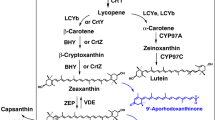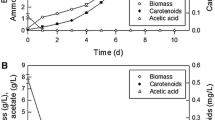Abstract
Rhodopseudomonas palustris is a purple photosynthetic bacterium that accumulates in the inner membrane the photosynthetic pigment spirilloxanthin, formed from lycopene. Here, we describe the procedures used to successfully engineer Rps. palustris strains to reroute the production of lycopene toward the synthesis of ß-carotene or canthaxanthin. The crtCD genes specifically involved in spirilloxanthin were replaced by crtY and crtW genes from Bradyrhizobium ORS278 to synthesize ß-carotene and (or) canthaxanthin, two pigments of industrial interest. Since the synthesis of canthaxanthin depends on the presence of oxygen, the procedure to optimize their production is also proposed. By modulating the light and oxygen during the growth process, a single species of photosynthetic bacteria, with an efficient growth rate, produces various carotenoids of economical interest.
Access this chapter
Tax calculation will be finalised at checkout
Purchases are for personal use only
Similar content being viewed by others
References
Takaichi S (1999) Carotenoids and carotenogenesis in anoxygenic photosynthetic bacteria. In: Frank HA, Young AJ, Britton G, Cogdell RJ (eds) The photochemistry of carotenoids. Kluwer Academic Publishers, Dordrecht
Moran NA, Jarkiv T (2010) Lateral transfer of genes from fungi underlines carotenoid production in aphids. Science 328:624–627
Di Mascio P, Kaiser S, Sies H (1989) Lycopene as the most efficient biological carotenoid singlet oxygen quencher. Arch Biochem Biophys 274:532–538
Kläui H (1982) Industrial and commercial uses of carotenoids. In: Britton G, Goodwin TW (eds) Carotenoid chemistry and biochemistry. Pergamon Press, Inc., Oxford
Simpson KL, Katayama T, Chichester CO (1981) Carotenoids in fish feeds. In: Bauernfeind JC (ed) Carotenoids as colorants and vitamin A precursors. Academic Press, Inc., New York
Harwood CS, Gibson J (1988) Anaerobic and aerobic metabolism of diverse aromatic compounds by the photosynthetic bacterium Rhodopseudomonas palustris. Appl Environ Microbiol 54:712–717
Larimer FW, Chain P, Hauser L et al (2004) Complete genome sequence of the metabolically versatile photosynthetic bacterium Rhodopseudomonas palustris. Nat Biotechnol 22:55–61
Giraud E, Fardoux J, Fourrier N et al (2002) Phytochrome controls the photosystem synthesis in anoxygenic bacteria. Nature 417:202–205
Giraud E, Zappa S, Jaubert M et al (2004) Bacteriophytochrome and regulation of the synthesis of the photosynthetic apparatus in Rhodopseudomonas palustris: pitfalls of using laboratory strains. Photochem Photobiol Sci 3:587–591
Lorquin J, Molouba F, Dreyfus BL (1997) Identification of the carotenoid canthaxanthin from photosynthetic Bradyrhizobium strains. Appl Environ Microbiol 63:1151–1154
Quandt J, Hynes MF (1993) Versatile suicide vectors which allow direct selection for gene replacement in gram-negative bacteria. Gene 127:15–21
Clayton RK (1963) Towards the isolation of a photochemical reaction center in Rhodopseudomonas sphaeroides. Biochim Biophys Acta 75(312–318):1963
Kojadinovic M, Laugraud A, Vuillet L et al (2008) Dual role for a bacteriophytochrome in the bioenergetic control of Rhodopsdeudomonas palustris: enhancement of photosystem synthesis and limitation of respiration. Biochim Biophys Acta 1777:163–172
Author information
Authors and Affiliations
Corresponding author
Editor information
Editors and Affiliations
Rights and permissions
Copyright information
© 2018 Springer Science+Business Media, LLC, part of Springer Nature
About this protocol
Cite this protocol
Giraud, E., Hannibal, L., Chaintreuil, C., Fardoux, J., Verméglio, A. (2018). Synthesis of Carotenoids of Industrial Interest in the Photosynthetic Bacterium Rhodopseudomonas palustris : Bioengineering and Growth Conditions. In: Barreiro, C., Barredo, JL. (eds) Microbial Carotenoids. Methods in Molecular Biology, vol 1852. Humana Press, New York, NY. https://doi.org/10.1007/978-1-4939-8742-9_12
Download citation
DOI: https://doi.org/10.1007/978-1-4939-8742-9_12
Published:
Publisher Name: Humana Press, New York, NY
Print ISBN: 978-1-4939-8741-2
Online ISBN: 978-1-4939-8742-9
eBook Packages: Springer Protocols




